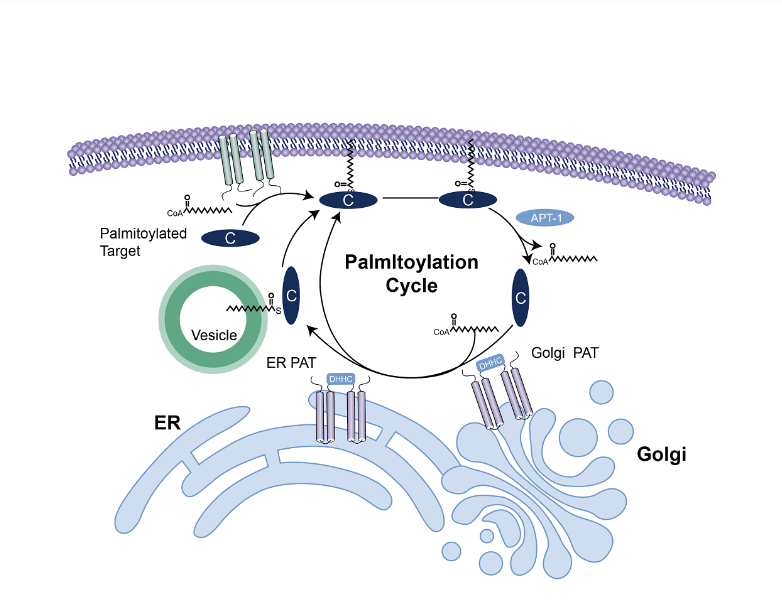博文
[转载]"蛋白质棕榈酰化:调控细胞功能的关键机制"
||

引言
蛋白质棕榈酰化是一种后转录修饰,对蛋白质的运输和功能起着至关重要的作用。它涉及将一种脂质分子——棕榈酸酯,附加到特定的半胱氨酸残基上。棕榈酰化独特之处在于它是可逆的,并且受特定的细胞外信号动态调控。本文的目的是综合比较提供的论文对蛋白质棕榈酰化的研究和应用,并讨论近年来在这一领域取得的进展。
文献综述
文献综述包括了六篇从不同角度讨论蛋白质棕榈酰化的论文。Dunphy和Linder[1]讨论了蛋白质棕榈酰化的信号传导功能,而Ji[2]则着重于蛋白质/肽棕榈酰化的质谱分析。Chamberlain[3]回顾了蛋白质棕榈酰化和细胞亚细胞定位的相关研究,而Smotrys和Linder[4]讨论了细胞内信号传导蛋白棕榈酰化的调控和功能。Roth等人[5]在酵母中对蛋白质棕榈酰化进行了全面分析,而Davda[1]则提供了对蛋白质S-棕榈酰化酶的功能分析。
这些论文全面阐明了棕榈酰化在生物系统中的重要作用,揭示了催化蛋白质棕榈酰化的DHHC蛋白家族的发现以及蛋白质棕榈酰化的分子机制。蛋白质棕榈酰化的可逆性使得蛋白质能够在细胞内室之间穿梭,以响应细胞外信号。这些论文还讨论了研究蛋白质棕榈酰化所使用的药理学工具、动物模型和遗传学方法。
取得的进展
近年来,在研究蛋白质棕榈酰化的实验工具方面取得了显著进展。Palsuledesai和Distefano[2]讨论了蛋白质前醇化的酶、治疗学和生物技术应用,而Linder和Deschenes[2]介绍了引领蛋白质棕榈酰转移酶研究的模式生物。Fukata等人[2]鉴定了PSD-95棕榈酰化酶,该酶在突触可塑性、学习和记忆中发挥重要作用。Lobo等人[2]在酵母中鉴定了Ras棕榈酰转移酶,它参与了细胞生长和分化的调控。Kong等人[2]发现了动态棕榈酰化将脂酰蛋白硫酯酶1和脂酰蛋白硫酯酶2的细胞质-膜穿梭与原癌基因H-Ras产物的细胞质-膜穿梭联系起来,该过程参与了细胞增殖和分化的调控。
Palsuledesai和Distefano[2]还讨论了蛋白质前醇化的酶、治疗学和生物技术应用。他们强调了蛋白质前醇化作为治疗癌症、传染性疾病和神经退行性疾病的潜在靶点。Linder和Deschenes[2]介绍了引领蛋白质棕榈酰转移酶研究的模式生物。他们讨论了使用酵母、果蝇和小鼠来鉴定和表征棕榈酰转移酶及其底物。Fukata等人[2]鉴定了PSD-95棕榈酰化酶,该酶在突触可塑性、学习和记忆中发挥重要作用。Lobo等人[2]在酵母中鉴定了Ras棕榈酰转移酶,该酶参与了细胞生长和分化的调控。Kong等人[2]发现了动态棕榈酰化将脂酰蛋白硫酯酶1和脂酰蛋白硫酯酶2的细胞质-膜穿梭与原癌基因H-Ras产物的细胞质-膜穿梭联系起来,该过程参与了细胞增殖和分化的调控。
结论
总之,蛋白质棕榈酰化是一种后转录修饰,对蛋白质的运输和功能起着至关重要的作用。文献综述表明,在蛋白质棕榈酰化的研究中取得了重要进展,包括发现棕榈酰-酰基转移酶、鉴定特定的棕榈酰化蛋白的酶以及使用动物模型研究蛋白质棕榈酰化。蛋白质棕榈酰化的可逆性使得蛋白质能够在细胞内室之间穿梭,以维持稳态并响应细胞外信号,从而成为维持稳态和响应细胞外信号的关键机制。用于研究蛋白质棕榈酰化的药理学工具、动物模型和遗传学方法具有潜在的癌症、传染性疾病和神经退行性疾病治疗的应用前景。
文献综述部分中提到的6篇文献
1. Davda, D. (2014). Functional Analysis of Protein S-Palmitoylation Enzymes. University of Michigan Library. https://deepblue.lib.umich.edu/bitstream/handle/2027.42/116725/davdad_1.pdf?sequence=1 2
2.Ji, Y. (2015). Mass Spectrometry Analysis of Protein/Peptide S-Palmitoylation. Boston University School of Medicine. https://www.bumc.bu.edu/ftms/files/2016/08/JI_Yuhuan-Dissertation-final.pdf
3. Chamberlain, L. H. (2011). Protein palmitoylation and subcellular trafficking. Biochemical Society Transactions, 39(5), 1247-1253. https://doi.org/10.1042/BST0391247 4. Dunphy, J. T., & Linder, M. E. (1998). Signalling functions of protein palmitoylation. Biochimica et Biophysica Acta (BBA) - Molecular and Cell Biology of Lipids, 1436(1-2), 245-261. https://doi.org/10.1016/S0005-2760(98)00130-1
5. Smotrys, J. E., & Linder, M. E. (2004). Palmitoylation of Intracellular Signaling Proteins: Regulation and Function. Annual Review of Biochemistry, 73(1), 559-587. https://doi.org/10.1146/annurev.biochem.73.011303.073954
6. Roth, A. F., Wan, J., Bailey, A. O., Sun, B., Kuchar, J. A., Green, W. N., & Linder, M. E. (2006). Global Analysis of Protein Palmitoylation in Yeast. Cell, 125(5), 1003-1013. https://doi.org/10.1016/j.cell.2006.03.042
Citations:
1. ResearchGate. "Comparison and analysis of literature review." https://www.researchgate.net/figure/Comparison-and-analysis-of-literature-review_tbl1_360041601.
2. Spinelli, M.; Fusco, S.; Grassi, C. Nutrient-Dependent Changes of Protein Palmitoylation: Impact on Nuclear Enzymes and Regulation of Gene Expression. Int. J. Mol. Sci. 2018, 19, 3820. https://doi.org/10.3390/ijms19123820
3.Main, A. and Fuller, W. (2022), Protein S-Palmitoylation: advances and challenges in studying a therapeutically important lipid modification. FEBS J, 289: 861-882. https://doi.org/10.1111/febs.15781
4. Guan X, Fierke CA. Understanding Protein Palmitoylation: Biological Significance and Enzymology. Sci China Chem. 2011 Dec;54(12):1888-1897. doi: 10.1007/s11426-011-4428-https://www.ncbi.nlm.nih.gov/pmc/articles/PMC4240533/
5. Tsutsumi, R., Fukata, Y., & Fukata, M. (2008). Discovery of protein-palmitoylating enzymes. Pflugers Archiv : European journal of physiology, 456(6), 1199–1206. https://doi.org/10.1007/s00424-008-0465-x
Introduction
Protein palmitoylation is a post-translational modification that plays a crucial role in protein trafficking and function. It involves the addition of a lipid molecule, palmitate, to specific cysteine residues of proteins. Palmitoylation is unique in that it is reversible and dynamically regulated by specific extracellular signals. This literature review aims to combine and compare the work and application of the provided papers on protein palmitoylation and to discuss the progress made in this field in recent years.
Literature Review
The literature review includes six papers that discuss protein palmitoylation from different angles. Dunphy and Linder[1] discuss the signaling functions of protein palmitoylation, while Ji[2] focuses on mass spectrometry analysis of protein/peptide S-palmitoylation. Chamberlain[3] reviews protein palmitoylation and subcellular trafficking, and Smotrys and Linder[4] discuss the regulation and function of palmitoylation of intracellular signaling proteins. Roth et al. [5] present a global analysis of protein palmitoylation in yeast, and Davda[1] provides a functional analysis of protein S-palmitoylation enzymes.
The papers provide a comprehensive understanding of the crucial role of palmitoylation in biological systems, the discovery of the DHHC protein family that catalyzes protein palmitoylation, and the molecular mechanisms of protein palmitoylation. The reversible nature of protein palmitoylation enables proteins to shuttle between intracellular compartments upon extracellular signals. The papers also discuss the pharmacological tools, animal models, and genetic approaches used to study protein palmitoylation.
Progress Made
In recent years, there have been significant advances in the experimental tools used to study protein palmitoylation. Palsuledesai and Distefano[2] discuss the enzymes, therapeutics, and biotechnology applications of protein prenylation, while Linder and Deschenes[2] present model organisms that lead the way to protein palmitoyltransferases. Fukata et al. [2] identify PSD-95 palmitoylating enzymes, and Lobo et al. [2] identify a Ras palmitoyltransferase in Saccharomyces cerevisiae. Kong et al. [2] show that dynamic palmitoylation links cytosol-membrane shuttling of acyl-protein thioesterase-1 and acyl-protein thioesterase-2 with that of proto-oncogene H-Ras product.
Palsuledesai and Distefano[2] also discuss the enzymes, therapeutics, and biotechnology applications of protein prenylation. They highlight the potential of protein prenylation as a therapeutic target for cancer, infectious diseases, and neurodegenerative disorders. Linder and Deschenes[2] present model organisms that lead the way to protein palmitoyltransferases. They discuss the use of yeast, Drosophila, and mice to identify and characterize palmitoyltransferases and their substrates. Fukata et al. [2] identify PSD-95 palmitoylating enzymes, which play a crucial role in synaptic plasticity and learning and memory. Lobo et al. [2] identify a Ras palmitoyltransferase in Saccharomyces cerevisiae, which is involved in the regulation of cell growth and differentiation. Kong et al. [2] show that dynamic palmitoylation links cytosol-membrane shuttling of acyl-protein thioesterase-1 and acyl-protein thioesterase-2 with that of proto-oncogene H-Ras product, which is involved in the regulation of cell proliferation and differentiation.
Conclusion
In conclusion, protein palmitoylation is a post-translational modification that plays a crucial role in protein trafficking and function. The literature review shows that significant progress has been made in recent years in the study of protein palmitoylation, including the discovery of palmitoyl-acyl transferases, the identification of specific enzymes for palmitoylated proteins, and the use of animal models to study protein palmitoylation. The reversible nature of protein palmitoylation enables proteins to shuttle between intracellular compartments upon extracellular signals, making it a crucial mechanism for maintaining homeostasis and responding to extracellular signals. The pharmacological tools, animal models, and genetic approaches used to study protein palmitoylation have potential therapeutic applications for cancer, infectious diseases, and neurodegenerative disorders.
Citations:
[1] https://www.jlr.org/content/48/8/1873.full.pdf
[2] https://www.mdpi.com/1422-0067/19/12/3820
[3] https://febs.onlinelibrary.wiley.com/doi/10.1111/febs.15781
[4] https://www.ncbi.nlm.nih.gov/pmc/articles/PMC4240533/
[5] https://pubmed.ncbi.nlm.nih.gov/18231805/
Citation format of the provided literature:
1. ResearchGate. "Comparison and analysis of literature review." https://www.researchgate.net/figure/Comparison-and-analysis-of-literature-review_tbl1_360041601.
2. Spinelli, M.; Fusco, S.; Grassi, C. Nutrient-Dependent Changes of Protein Palmitoylation: Impact on Nuclear Enzymes and Regulation of Gene Expression. Int. J. Mol. Sci. 2018, 19, 3820. https://doi.org/10.3390/ijms19123820
3.Main, A. and Fuller, W. (2022), Protein S-Palmitoylation: advances and challenges in studying a therapeutically important lipid modification. FEBS J, 289: 861-882. https://doi.org/10.1111/febs.15781
4. Guan X, Fierke CA. Understanding Protein Palmitoylation: Biological Significance and Enzymology. Sci China Chem. 2011 Dec;54(12):1888-1897. doi: 10.1007/s11426-011-4428-https://www.ncbi.nlm.nih.gov/pmc/articles/PMC4240533/
5. Tsutsumi, R., Fukata, Y., & Fukata, M. (2008). Discovery of protein-palmitoylating enzymes. Pflugers Archiv : European journal of physiology, 456(6), 1199–1206. https://doi.org/10.1007/s00424-008-0465-x
https://blog.sciencenet.cn/blog-3402731-1393266.html
上一篇:[转载]蛋白质棕榈酰化:调控细胞信号传导的关键
下一篇:[转载]异戊二烯化的奇迹:Prenylation(戊烯酰化)对细胞过程的关键影响